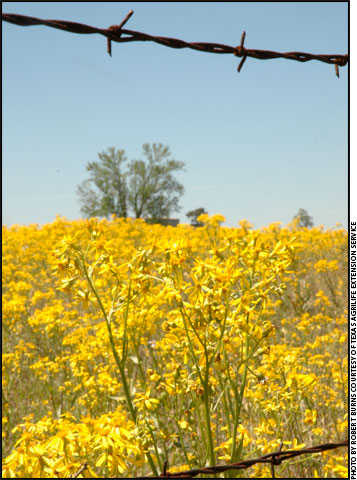
Cutbacks of fertilizer on Bermuda grass pastures mean beef producers are seeing more cool-season weeds such as Texas groundsel, according to a Texas AgriLife Extension Service forage specialist.
Weeds, Weeds, Weeds
Forage specialist offers tips on how to prevent, eliminate bothersome weeds.
Beef producers throughout Texas are having problems with cool-season weeds and will likely have problems with warm-season annual weeds as the year progresses, according to reports from Texas AgriLife Extension Service personnel. Though it's not a crisis situation, it is a prevalent one reported by AgriLife Extension agents in many counties in the last few weeks.
"Some of the more common weeds in East Texas pastures are wooly croton, aka dove weed; blackberry or dewberry; thistles; and nettles," says Vanessa Corriher, AgriLife Extension forage specialist. "The weed issues in other areas of the state will depend upon those particular eco-regions. As you move into the western rangeland, you often get into more brush species like mesquite, huisache and pricklypear."
East Texas still has ryegrass pastures. Henbit, chickweed and Texas groundsel — all winter annuals — are the most common weeds, she says. As soil temperatures rise, there will be more warm-season weeds such as thistles and wooly croton.
Prevention
While many producers may suspect the unusually wet winter and spring to be behind the flush of weeds, the most likely cause, particularly when it comes to improved pastures, is a poor fertility program, Corriher says. Lower-than-optimum fertility — cutting back on fertilizers such as nitrogen, potassium and phosphorus — means the improved forages such as Bermuda grass are less able to compete with weeds. But high costs of fertilizers and the poor economy have forced many producers to cut back on their fertility programs, in some cases eliminating one of the primary nutrients altogether.
"Soil-test recommendations are no higher than necessary to maintain optimum yields and a persistent stand," she says. "However, if one must cut back, do so uniformly. If the recommendation is for nitrogen, phosphorous and potassium, be sure to apply each in the same proportion, even if you have to do so at a reduced rate. Just don't apply nitrogen alone."
The nutrients are interdependent, she reasons. Applying one or two without the others will likely mean the ones that are applied won't be effective, she says.
Control
As for control of existing weeds, the options are mechanical or chemical control, she says.
"Proper use of a herbicide can be more economical than mowing or shredding," she says. "According to an AgriLife Extension study by Greg Clary (AgriLife Extension economist) and Larry Redmon (AgriLife Extension agronomist), producers can save about $3.70 an acre with the proper use of a herbicide control."
Corriher notes the comparison study was made using a 40-horsepower (hp) tractor with either a 6-foot (ft.) rotary mower or a 30-ft. boom sprayer applying GrazonNext™ at 1 quart per acre. Other general broadleaf weed control options beside GrazonNext include 2,4-D, Grazon® P+D, Cimarron® (Plus, Max, Extra), Range Star™ and Chaparral™.
Corriher cautions that when using herbicides, producers should follow label directions for application rate, timing of application, grazing restrictions, and cleanup and disposal.
Sometimes there is a third option for weed control: cattle. Sometimes the perceived weed is not a weed at all from the point of view of livestock, she explains.
"Many producers hate to see crabgrass in their pastures or hay meadows," she says. "But in terms of nutrition, it can be on par with coastal Bermuda grass."
For proper identification of weed species, Corriher recommends producers consult with the AgriLife Extension office in their county.
Producers often call or e-mail Corriher with information about a weed they've found, but even when there's a picture included in the e-mail, it's not the most efficient means of identifying it. Mailing an actual weed sample doesn't work well either, because by the time the sample has arrived, it is most often too deteriorated to be of any use for identification, she says.
"In most cases, the county agent will be able to identify the weed and (quickly) recommend control measures for all but the oddball weeds," she says.
Contact information for the AgriLife Extension office in any county can be found online at http://county-tx.tamu.edu/.





